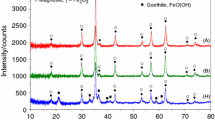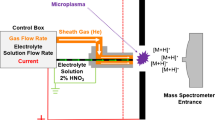Abstract
Out of many applications of hydrogen plasma, reduction of metal oxides is an important one. The reduction can be carried out using carbon or hydrogen. While carrying out the reduction of hematite (Fe2O3) in hydrogen plasma, an attempt was made to characterize the hydrogen plasma by optical emission spectroscopy. The spectroscopic results provide some new and useful information. In addition to the hydrogen emission lines, two prominent lines at 589 and 589.6 nm were observed. These two lines are confirmed to be sodium D1 and D2 (Na D lines) by comparing with a low pressure sodium vapour lamp (LPSVL). The source of the trace amount of sodium is also confirmed to be from the metal oxide sample as an impurity. These lines are found to be very sensitive to various process parameters such as gas flow rate, microwave power, and reduction chamber pressure. The temporal variation of these two Na D lines also shows a characteristic trend during metal oxide reduction in hydrogen plasma. The weight loss and the X-ray diffraction analyses of reduced Fe2O3 sample for different time duration provides the evidence of correlation with Na D lines’ intensity trend. This trend can be used to monitor the state and completion of hydrogen plasma based reduction reaction. In processes where Na is not associated with metal oxide, trace amount of Na in its molecular form such as NaOH can be introduced for monitoring the plasma process parameters as well as the plasma based reduction process.












Similar content being viewed by others
References
Sabat KC, Rajput P, Paramguru RK, Bhoi B, Mishra BK (2014) Plasma Chem Plasma Process 34(1):1–23
Rajput P, Bhoi B, Sahoo S, Paramguru RK, Mishra BK (2013) Ironmak Steelmak 40(1):61–68
Rajput P, Sabat KC, Paramguru RK, Bhoi B, Mishra BK (2014) Ironmak Steelmak 41(10):721–731. doi:10.1179/1743281214Y.0000000186
Sabat KC, Paramguru RK, Pradhan S, Mishra BK (2015) Plasma Chem Plasma Process 35:387–399
Garcia MC, Varo M, Martınez P (2010) Plasma Chem Plasma Process 30:241–255
Maslani A, Sember V, Stehrer T, Pauser H (2013) Plasma Chem Plasma Process 33:593–604
Sember V, Maslani A, Krenek P, Heinrich M, Nimmervoll R, Pauser H, Hrabovsky M (2011) Plasma Chem Plasma Process 31:755–770
Yamada T, Ohmi H, Kakiuchi H, Yasutake K (2013) Plasma Chem Plasma Process 33:797–806
Jia H, Fujiwara H, Kondo M, Kuraseko H (2008) J Appl Phys 104:054908
Mackus AJM, Heil SBS, Langereis E, Knoops HCM, Sanden MCM, Kessels WMM (2010) J Vac Sci Technol A 28(1):77–87
Kim M, Kahng YH, Kim YJ, Kumar TP, Park KM (2013) AIP Adv 3:032121(1–7). doi:10.1063/1.4795240
Plane J, Oetjen H, Miranda MD, Lopez AS, Gausa M, Williams B (2012) J Atmos Sol Terr Phys 74:181–188
Kim KS (1987) Sol Phys 114:47–64
Hossain MM, Pant TK, Vineeth C, Sumod SG, Sridharan R (2010) Ann Geophys 28:2071–2077
Slanger TG, Cosby PC, Huestis DL, Lopez AS, Murray BJ, Osullivan DA, Plane JMC, Prieto CA, Torres FJM, Jenniskens P (2005) J Geophys Res 110:1–8. doi:10.1029/2005JD006078
Cvelbar U, Krstulovic N, Milosevic S, Mozetic M (2008) Vacuum 82:224–227
Carnevali S, Proust C, Soucille M (2013) Chem Eng Res Des 91:633–639
Acknowledgments
The authors would like to acknowledge the financial assistance of Ministry of Steel, Govt. of India, through GAP-208 project and CSIR through FAC-11 and OLP-50 projects. Sarita Das would like to thank CSIR for financial assistance through CSIR-SRF fellowship. The authors are also thankful to Mr. Jogeswar Sahu and Dr. S. K. Mishra for sample characterization.
Author information
Authors and Affiliations
Corresponding author
Rights and permissions
About this article
Cite this article
Das, S., Das, D.P., Rajput, P. et al. Monitoring Hydrogen Plasma Reduction of Oxides by Na D Lines. Plasma Chem Plasma Process 36, 1125–1139 (2016). https://doi.org/10.1007/s11090-016-9705-6
Received:
Accepted:
Published:
Issue Date:
DOI: https://doi.org/10.1007/s11090-016-9705-6




